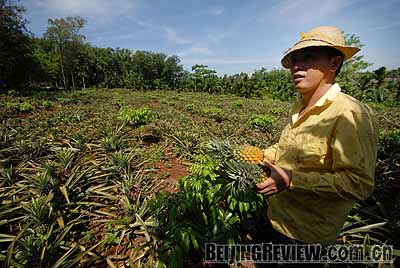|

The late morning sun shone on a cluster of palm trees under which a grandfather murmured something to his grandson lying in a hammock hung between trees. Close by a middle-aged man swung in another hammock whistling a song, his motorcycle quietly leaning against a tree.
"You see those concrete paths there? I built them," said the grandfather, Liang Dingshi, a farmer in his 50s who lives in Longlian Village. Liang worked on a village renovation program that started in 2007: painting houses, building concrete roads, and constructing modern toilets and other public facilities.
"The villagers prepared the construction materials, and we organized them to build these new paths around their houses," said Liang Jun, the village head.
As for the construction of the main roads and the public facilities, including a volleyball playground, the money came from government funds and the villagers. "The village renovation project cost some 210,000 yuan ($30,000) in 2007, of which 90,000 ($12,800) was invested by the government and the rest was collected from the villagers," the village head told Beijing Review.
New look
Longlian is just one of the 7,800 remodeled villages in China's southernmost Hainan Province, which began to transform into an environment-friendly, well-off community in 2000.
"Based on the villages, we want to build a new countryside featuring a favorable ecological environment, economy and culture," said Han Jiangfan, a provincial official in charge of the countryside construction. Han gave some statistics showing that by the end of 2007, 33 percent of the province's 23,000 villages had been included in the grand countryside transformation project.
"You would never want to come to our village when it was muddy, shabby and smelly," said Liang, the village head. Before the renovations, the village did not have any concrete roads and after rainstorms the paths turned to mud. Chickens, ducks and pigs wandered freely among the houses, leaving their droppings everywhere.
Now almost every household in the village has a modern toilet room in its yard. "At first we told villagers the advantages of the new toilets and offered people who built one 150 yuan ($21) as subsidy," Liang said.
According to Han, the countryside of Hainan Province has an advantage over mainland areas of China. "The vegetation coverage in Hainan's countryside is high. The forest coverage rate was 57 percent in 2007 for the whole province, three times that of the national average," Han said. "It's comparatively easier for us to build the countryside into a garden-like paradise."
In the nearby village of Tianxin, there is a story about how the area became a haven for egrets. In 1987, a veteran doctor in the village found a wounded egret in a tree near his home and helped it to recover. Months later the recovered egret began to mate and breed. After two decades there were tens of thousands of egrets in the woods to the east of the village.
"The birds are really a precious gift to our village. Besides the regular village renovation projects, the villagers voluntarily built a tour path in the woods at their own expense for the villagers and outsiders to come to see these beautiful birds," said village head Chen Yuexian.
The villagers and birds live in harmony with each other. "Sometimes villagers from other areas nearby would come to shoot these birds for meat and we have to stop them. Last year we caught an illegal hunter and he was sent to prison for some time," Chen said.
Economic restructuring
Restructuring the area's economic pattern is an important task of the new countryside construction program. In Longlian Village, the amount of livestock has been decreased for economic and environmental reasons.
"Only one household in the village is still raising pigs. We encouraged our farmers to grow more cash crops like rubber plants and peppers, which are more profitable than raising scattered livestock," said Liang, the village head. He added that the per-capita income in the village had risen to 6,800 yuan ($971) in 2007, an increase of 1,500 yuan ($214) over 2006.
Liang said several households in his village had begun raising frogs using self-built pools, in some cases adding as much as 10,000 yuan ($1,400) to their annual family income.
According to Chen, his village plans to build a large-scale pig farm in the coming years. "We are aiming at mass breeding that can produce 10,000 pigs each year," said the ambitious young chief.
As the environment improves, some villages have begun to develop tourism. "Tourists from the cities can fish in the lakes, try our rustic food and watch excellent countryside entertainment shows," said Liang, who is very confident about the future of his village.
For some villages, the countryside construction project has been a way out of poverty. In 2003, two thirds of the 72 households in Li minority-dominated Fangman Village were below the poverty line with per capita income of 1,152 yuan ($164).
After two years of poverty-alleviation measures, which changed the village both environmentally and economically, per-capita income there had risen to 1,943 yuan ($277) by 2005, a year-on-year increase of 31 percent.
Statistics show the province has devoted 840 million yuan ($120 million) to helping the poor since 1988. The poverty-stricken population had been reduced to 128,000 by the end of 2007 from 2 million in 1987. | 